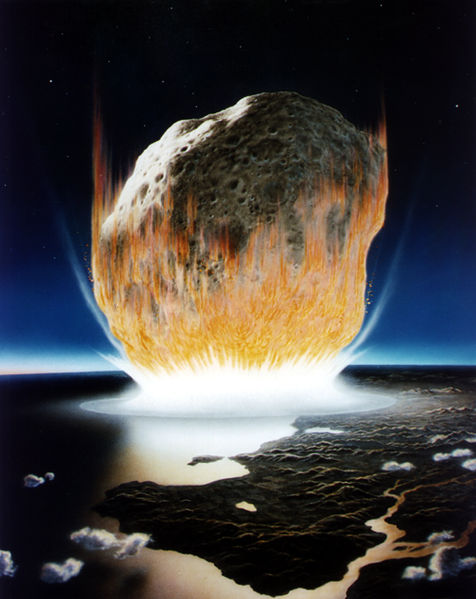A team led by Paul Renne at the Berkeley Geochronology Center in California have shed new light on the asteroid impact that is believed to have wiped out the dinosaurs, 66 million years ago. Writing in the journal Nature this week, the team use a new technique to date both the extinction event and the nearly coeval asteroid impact, to better understand the sequence of events around what is known as the Cretaceous-Paleogene Boundary.
 The extinction event at the Cretaceous-Paleogene Boundary was the most dramatic change to life on Earth, at least in the past 200 million years. It is estimated that at least 75% of species became extinct within a period of around a million years, including all species of flightless dinosaurs.
The extinction event at the Cretaceous-Paleogene Boundary was the most dramatic change to life on Earth, at least in the past 200 million years. It is estimated that at least 75% of species became extinct within a period of around a million years, including all species of flightless dinosaurs.
The puzzle in recent decades has been to work out what global change could have triggered such a catastrophe for the dinosaurs, which up until this point had thrived for tens of millions of years.
The evidence implicating a large asteroid impact is strong: rock deposits dating from the period are rich in iridium, a metal which is normally very rare on the surface of the Earth, but much more common in asteroids.
If an asteroid measuring around 10 km across collided with the Earth, throwing a large amount of debris into the atmosphere, this would explain the sudden abundance of iridium. It would also been very bad news for the dinosaurs, as the atmospheric debris would have obscured the Sun's light for a period of years, triggering the Earth to become a much colder place. It would also explain why plant life - unable to photosynthesise without much light from the Sun - was also particularly badly affected.
A large crater has even been identified near Chicxulub in Mexico which has almost exactly the right age.
But more recent studies have questioned whether this crater and the iridium deposits are really coeval with the extinction of the dinosaurs, or whether they actually date from 200,000 years later. Putting together the exact sequence of events has proven extremely challenging because of the length of time that has elapsed since.
Paul Renne's team made use of a new dating technique, using the very slow radioactive decay of some potassium atoms to form argon over periods of tens of millions of years. By looking at how much argon has accumulated in any given rock, they can arrive at the most precise ages ever derived for them.
Looking at rock layers associated both with the extinction at the Cretaceous-Paleogene Boundary, and also with the asteroid impact, the team have arrived at the most precise sequencing of events ever obtained. They conclude that the extinction event was already underway before the Chicxulub asteroid impact - probably because of changes to the Earth's climate - but also that the asteroid impact occurred while it was still underway. They conclude that dinosaur populations were already struggling to survive before the asteroid struck, but that the additional cooling triggered in the aftermath of the asteroid impact is likely to have provided the fatal blow.










Comments
Add a comment